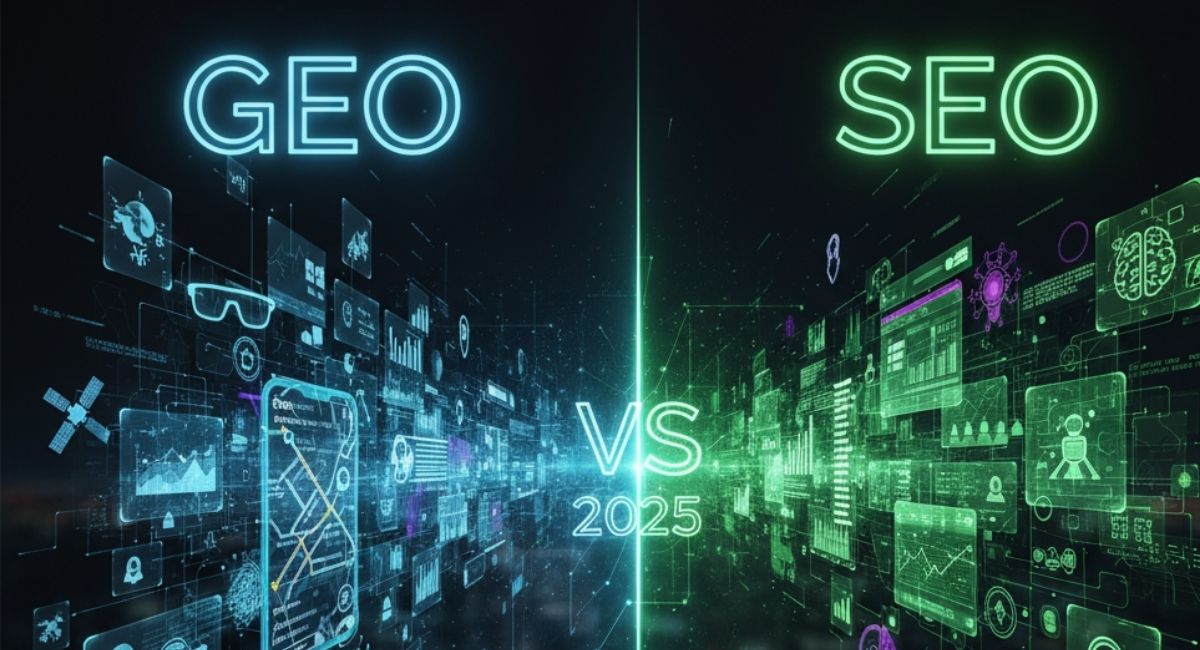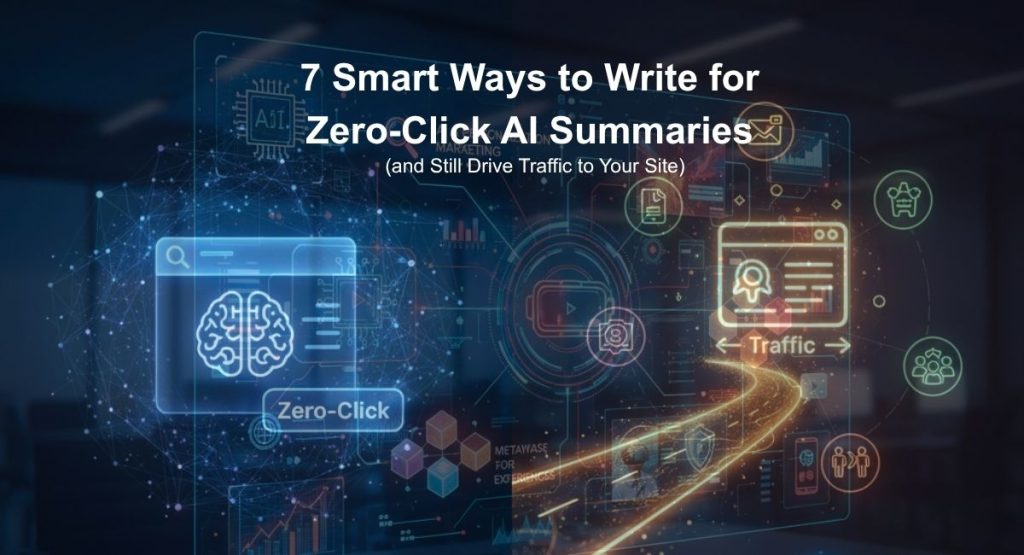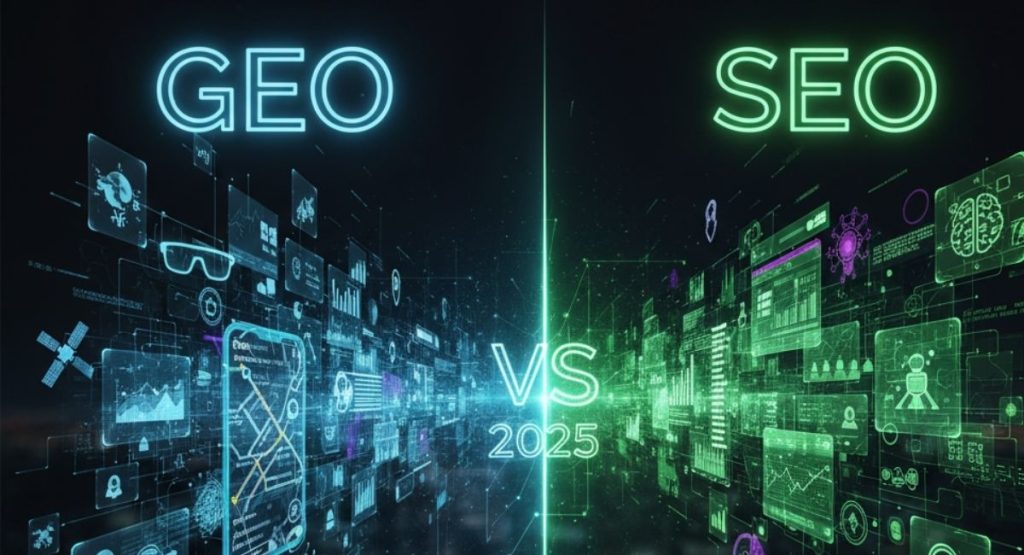Search is no longer what it used to be. Not long ago, digital marketers were focused almost entirely on traditional SEO: keywords, backlinks, meta tags, and website speed. For years, these factors dictated who ranked on Google’s first page. But by 2025, the conversation has expanded. Search isn’t just about keywords anymore. It’s about AI-driven experiences that create answers instantly, often before a user even clicks a website. This is where GEO (Generative Engine Optimization) comes into play.
If you’re a business owner or marketer, you’re probably asking yourself: Do I still need SEO? Should I pivot to GEO? How do I prepare for both?
The truth is, it’s not an either-or situation. The future belongs to those who combine strategies. In this manual guide, we’ll break down GEO vs. SEO, explore how AI search is reshaping visibility, and outline practical steps businesses can take to thrive. Along the way, we’ll highlight how SEO marketing services are already evolving to meet these changes.
Why the GEO vs. SEO Debate Matters Now
Think about how people search today. Ten years ago, someone might have typed “best pizza near me” into Google, clicked through a few sites, and compared menus. Today, the same person might ask their phone: “Where should I order pizza tonight?” Instead of browsing websites, they’ll hear an AI assistant like Siri, Google, or ChatGPT summarize options in seconds.
This shift isn’t small. It’s a fundamental change in user behavior. GEO acknowledges that search engines are becoming answer engines. Instead of being gateways to websites, they’re increasingly becoming the destination themselves.
For brands, this raises a challenge: How do you stay visible if users don’t always click?
SEO will continue to drive traffic from people who want deeper information. But GEO ensures your business shows up in AI-generated responses, which are fast becoming the default for many users. Missing out on either means leaving visibility—and customers—on the table.
GEO vs. SEO in 2025: A Detailed Breakdown
Here’s a deeper look at how these two optimization methods compare:
| Aspect | SEO (Search Engine Optimization) | GEO (Generative Engine Optimization) |
| Purpose | Rank higher in SERPs and attract clicks | Be cited in AI-generated responses |
| Approach | Keywords, backlinks, technical site health | Conversational, structured, fact-rich optimization |
| Content Focus | Long-form blogs, landing pages, guides | Concise, answer-ready data and FAQs |
| Ranking Factors | Keywords, E-E-A-T (Experience, Expertise, Authority, Trust), speed, links | Data clarity, trustworthiness, topical relevance |
| Platforms | Google Search, Bing SERPs, Yahoo | Google SGE, Bing Chat, ChatGPT, Perplexity AI |
| Business Outcome | Website visits, conversions, long-term traffic | Brand mentions in answers, visibility without clicks |
Notice the difference in intent. SEO wants the user to click through. GEO wants the user to trust your brand enough to be included in the AI’s response. Ideally, your strategy balances both.
The Human Side of Search: Why GEO Feels Different
SEO is about building digital visibility, but GEO feels more personal. AI-generated answers mimic human conversation. Instead of reading ten headlines, a user gets something like:
“Based on your query, here are three reliable Shopify web development approaches for 2025. Many businesses are now focusing on headless commerce for flexibility, AI-driven personalization for user experience, and fast-loading designs optimized for mobile shoppers.”
If your content provided the foundation for that answer, your brand is effectively part of the conversation. Even if the user doesn’t click, you’ve built trust and recognition. Over time, that matters as much as traffic.
That’s why Generative Engine Optimization feels closer to human interaction. It’s about anticipating questions, providing precise knowledge, and presenting it in ways AI can easily share.
SEO Still Matters: Why GEO Alone Isn’t Enough
Some marketers argue that GEO will replace SEO. But the truth is, both play complementary roles. Here’s why SEO still matters in 2025:
- Search engines remain dominant: Billions of queries still happen daily on Google.
- Clicks still drive sales: Generative answers provide exposure, but websites still convert customers.
- Authority signals overlap: GEO often looks to SEO-based authority signals like backlinks and content quality when deciding what to reference.
For instance, if you want your ecommerce store to thrive, you’ll still need optimized product listings, technical SEO, and strong category pages. GEO visibility helps introduce your brand, but SEO ensures you capture and convert customers. A well-structured site with ecommerce web development behind it performs best in both environments.
How to Build a Hybrid GEO + SEO Strategy
The real winners in 2025 will be the businesses that bridge the two. Here’s a practical framework to follow:
- Content That Educates and Summarizes
Instead of only writing 2,000-word articles, include clear summaries, bullet points, and FAQs. AI engines love well-structured, digestible data. - Schema and Structured Data
Add schema markup to articles, products, and services. This helps AI and search engines understand relationships between your content. - E-E-A-T at Scale
Build trust with expert voices, cited data, and transparent authorship. AI is trained to prioritize reliable information. - Topic Clusters Over Single Posts
Don’t just write one blog about local SEO. Build a cluster of interconnected content that covers strategy, benefits, tools, and case studies. - Technical SEO for Performance
Fast, secure, and mobile-friendly websites are essential. GEO doesn’t ignore technical quality. A slow, unoptimized site won’t be prioritized. - Monitor Generative Visibility
Tools are emerging to measure how often your brand appears in generative answers. Treat this as seriously as you treat SERP rankings.
Example in Action: Local SEO vs GEO
Imagine you run a bakery in Manhattan. With traditional SEO, you optimize for “best bakery near Central Park.” You build backlinks, list your business on Google Maps, and write blogs about local events. This attracts foot traffic from searchers.
With GEO, someone might ask ChatGPT or Google SGE: “Where’s a bakery with gluten-free croissants near Central Park?” If your website has FAQ sections, schema data, and descriptive menus, the AI may mention your bakery in the generative response.
The takeaway: SEO brings traffic; GEO builds trust and brand recognition at the conversational level. Together, they amplify each other.
GEO vs. SEO in E-commerce
Ecommerce businesses face unique challenges with GEO and SEO. Let’s break it down:
- SEO for ecommerce: Optimized product descriptions, category pages, schema for reviews, and technical speed improvements.
- GEO for ecommerce: Concise, AI-friendly product descriptions that answer specific questions. Example: “Is this product vegan?”
This is why many online stores are investing in Shopify web development and WooCommerce optimization. These platforms allow better integration of structured product data, which helps both search and AI engines recognize your inventory accurately.
Practical GEO and SEO Checklist for 2025
Here’s a working checklist businesses can use:
- Write long-form content, but include 150–200 word summaries.
- Add FAQ sections to every service or product page.
- Use schema for reviews, events, FAQs, and products.
- Build topic clusters instead of isolated blogs.
- Track both SEO rankings and generative mentions.
- Update older content to answer AI-driven questions.
- Secure your site with HTTPS and optimize for speed.
By combining these steps, you’ll position your business for visibility across both traditional and AI-driven search environments.
FAQs: GEO vs SEO in 2025
Q: What is GEO, and how is it different from SEO?
GEO is Generative Engine Optimization, focusing on visibility in AI-generated answers. SEO is about ranking in search engine result pages. Together, they cover both traditional search and AI-driven platforms.
Q: Should I rewrite all my old content for GEO?
Not necessarily. Start by updating your most important pages. Add summaries, FAQs, and structured data. Over time, you can expand to other content.
Q: How do I know if my content is showing in AI answers?
Some SEO tools now track generative mentions. You can also test queries in Google SGE or Bing Chat to see if your brand appears.
Q: Does GEO work for local businesses?
Yes. Local businesses should optimize their service pages with clear, structured information. GEO ensures you show up in AI-generated recommendations.
Q: What role does AI content ranking play?
AI content ranking decides how AI chooses which sources to cite in answers. Factors include authority, data clarity, and reliability.
The Future of GEO and SEO
In 2025, search is no longer confined to blue links and snippets. It’s conversational, AI-driven, and context-aware. But that doesn’t mean the traditional pillars of SEO are gone. Instead, GEO is becoming the natural extension of SEO, and the businesses that recognize this will thrive.
If your business wants to prepare for this new era, consider investing in SEO strategy services that already incorporate GEO practices. At Maxim Blu, we help brands merge classic optimization with AI-driven approaches to stay ahead of the curve.
The search landscape may be evolving quickly, but with the right strategy, your business can adapt, compete, and grow.




